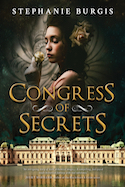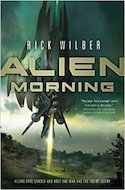Archives of The Future Alternative Past
The Future Alternative Past: Writers gotta write, readers gotta read
Every month, Nisi Shawl presents us with news and updates from her perch overlooking the world of science-fiction, fantasy, and horror. Read past columns here
Not what it used to be
The future science fiction depicts has never been the future. So-called Golden Age SFFH of the late 1930s to mid-1940s projected its times’ values and aesthetics onto imaginary eras flung far over the event horizon. Robert A. Heinlein’s literal space cadets, like his juvenile hero Matt Dodson, are all heterosexual men, though daringly cosmopolitan in their inclusion of differing nationalities — one of them even speaks French! Later, New Wave SFFH from the 1960s and 1970s espoused antiestablishment rebelliousness in the spirit of contemporary countercultural freakazoids like Abbie Hoffman and feminist SFFH authors including Ursula K. Le Guin and Joanna Russ pulled off populating the future widely with women-as-subjects rather than “love interests” or unattainable ideals thanks to the then-current examples of Gloria Steinem and Mary Ann Weathers. As the real-life present changesthe SFFH future does too. Because the present is what it’s based on.
Sometimes there are gaps in the projection. SFFH’s gatekeepers — publishers, editors, agents, producers, distributors, reviewers — may not feel the zeitgeist some authors are trying to represent. Or a few years pass in which features of the present that some authors want to riff off of can’t be plausibly placed in what’s called a “near-future scenario”: a setting mere decades off. You’d think doing that would be easier than making a case for far-future stuff, but no. An analogy: a character in Isaac Asimov’s story “The Ugly Little Boy” likens time travel to scratching your ear. It’s easier to do with your fingers than your elbow, though the latter’s anatomically closer. And it’s easier to posit certain changes as manifesting in a distant epoch than trying to plot out the path we’ll take between now and then.
Sometimes the continuous parade of global events or scientific discoveries renders a particular future dissonant with the resulting new present. These dissonances can accumulate: the absence of pocket calculators, cell phones, and GPS on the technological side; no trace of Brexit or Trump’s presidency on the political. Suddenly whole oeuvres, whole shelves, entire imprints lose their tenuous verisimilitude. The works of Heinlein and Asimov are obvious examples, but no writer is immune to this trap. For instance, my stories “Lazzrus” and “Sunshine of Your Love” — one published in November and the other yet to appear — mention a connection between cloning and obesity, but since I wrote about it that connection has been disproven. Stories such as mine can now only be appreciated as historical artifacts despite the dates they supposedly occur.
Social evolution also causes whole swathes of SFFH to date. Many SFFH classics impress newer readers as horribly offensive. Sexism and misogyny, racism, ableism, and other discriminatory mindsets pair frequently and unselfconsciously with more progressive and deliberately provocative attitudes; look at Bester’s The Stars My Destination and McCaffrey’s The Ship Who Sang.
What’s the solution? For us authors, the answer is to keep writing. Write some more. Write what works in the moment, and don’t worry that the moment ends, demolishing as it can your most recent futures.
Writers gotta write. Readers gotta read.
Keep reading. Keep writing. And SFFH’s futures will die only to be reborn.
Recent books recently read
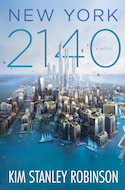
Kim Stanley Robinson’s latest novel, New York 2140 (Orbit), is as large and complex as the city it’s named for. Ever optimistic, Robinson depicts a Manhattan that despite being half-drowned by melting polar ice caps rises Venice-like to meet the challenges of hurricanes and investment capital with its celebrated insouciance. The author has famously advocated for the shameless use of infodumps — those frequently lamented expository passages so often necessary to the construction of SFFH’s brave new worlds. Entire chapters of this book are nothing but. Readers who look down on infodumps can easily avoid them. Why would you want to, though? They’re relatively short and scattered through with treasures. And they blend so well with the rest of the book’s chapters, written from the viewpoints of a reality show star-cum-dirigible pilot, a pair of subversive finance software specialists, a big black cop more than a little reminiscent of the late Octavia E. Butler, and others. Viewpoint and non-viewpoint characters are fascinating, believable, and varied. Add Robinson’s vivid descriptions of natural and artificial beauty and his inventive neologisms — portmanteau words like delanyden and gehryglory — and the result is a portrait of a protean, mythical New York, a place deserving of our honor, our respect, our attention, and our lasting love.
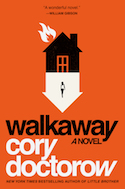
Just as optimistically disruptive, Electronic Frontier Foundation advocate Cory Doctorow gives us Walkaway (Tor), a novel daringly bridging the gap between a highly likely near-future dystopia and a happy post-human millennium. The effortlessly involving plot follows the sexual and romantic entanglements, guerilla parties, philosophical arguments, torture, kidnapping, and escapes of a disaffected heiress with the nom de guerre Iceweasel; an outer-space-hungry cross-dresser named Kersplebedeb; Disjointed, an aging scientist working on a cure for death; and a dozen more revolutionaries. In this fictional world the word “walkaway” is both a verb and a noun. When you walkaway, you lay aside all conventional burdens and burdensome conventionality and head for a walkaway, which is an anarchic place like Hakim Bey’s Temporary Autonomous Zones, but more widespread, and supported by an impressive array of abundance tech. In contrast to what’s termed the “default,” no one works unless they want to, no one gets paid, no one starves, no one fights. How do we bring about the future we want? By living as if it’s already here, say Doctorow and those of his characters who walkaway.
Couple of upcoming cons
Sometimes cons resemble TAZs. At the International Conference on the Fantastic in the Arts last month, another attendee asked me which con was my favorite. Like at least half the people partaking in that convo I named WisCon. Certainly it’s the preeminent gathering of feminist SFFH fans in this hemisphere. Certainly it’s the most thoughtful congeries of Social Justice Warriors this side of the Inn Earnest Giraffe Emulation. And certainly I’ll be going again this year, along with my mother, who in the audience of her first James Tiptree, Jr. auction there laughed helplessly at the idea of trying to explain to her friends exactly what these whacky women were doing. (I think this was during the Titty-Shaking Duel.) You should probably go, too.
Then there’s the Nebula Conference, aka “the Nebs.” It’s a weekend of workshops, panels, and disco anthem performances, culminating in a nerve-wracking ceremonial banquet for those on the Nebula Award’s final ballot. Like me. I’ll be working a paying gig, though, so perhaps you should go in my place?
The Future Alternative Past: can untaught writing be taut?
Every month, Nisi Shawl presents us with news and updates from her perch overlooking the world of science-fiction, fantasy, and horror. Read past columns here
Can and can’t
Many people say you can’t teach anyone to write. Just Google the phrase “Can’t teach how to write.” Half your hits will be refutations of the idea — which means half those discussing it think it needs refuting. Creative writing programs proliferate across the country, around the world, and all through the virtual ether — and yet they’re slammed by pros as too academic, too expensive, for dilettantes, for cowards, a scam to employ lazy and/or inept has-beens as teachers and enrich institutions catering to the dimwit dreams of talentless wannabes. The thing to do if you want to write, detractors of formalized writing instruction opine, is to actually write. You can learn to write, they say, but only from yourself.
What can be learned can be taught, counter the refuters. Writing is not an innate talent. It’s a skill. It can be imparted.
From my perch in Genreland I see both sides. As genius author and critic Samuel R. Delany wrote in Starboard Wine, in an essay titled “Some Presumptuous Approaches to Science Fiction,” the ability to read SF is an acquired one. Seeing words such as “The red sun is high, the blue low” on a page calls for work on the reader’s part. Why is the first sun red? Atmospheric interference? Age? Plus there are two suns — so neither is Earth’s sun — which is yellow, right? And on and on...readers familiar with the possibilities produced by just one SF sentence take them into account easily, and are easily able to handle the similar wealth of possibilities inherent in some fantasy and horror texts. Mundanes (the SFFH community’s term for outsiders) almost always have a harder time. They’re unused to the protocols that help us discriminate between literal and figurative versions of statements such as “Her head exploded.” And without understanding those protocols, SFFH is as difficult to write SFFH as it is to read.
One remedy for being outside the SFFH community is to enter it. Being surrounded by others who see what Howard Waldrop is saying does great things to one’s gestalt. Reading, participating in discussions, attending conventions and film festivals, and taking workshops are all good ways of getting inside. At Clarion West, Clarion, Milford, Viable Paradise, and other SFFH writing workshops, students learn from each other as well as from the official instructors.
There are also books to assist us: Cory Doctorow’s The Complete Idiot’s Guide to Publishing Science Fiction, Ursula K. Le Guin’s Steering the Craft, and Writing the Other: Bridging Cultural Differences for Successful Fiction, to name a few. The last example was based on the class of the same name I taught with my co-author, Cynthia Ward, which shows you that I not only think it’s possible to teach writing SFFH, I have even actually attempted it.
But I restrict myself in these attempts. I focus on particular elements of writing SFFH: dialogue and dialect, narration and inclusivity, characterization and representation. Most of the time these daysI teach online in partnership with K. Tempest Bradford, and we expand on specific topics covered in the Writing the Other book.
Is teaching writing possible? Do I succeed? Authors tell me they’ve written entire books because they took my course or read my book. But there are bound to be failures. Some people are just no good at writing, and no good at writing SFFH in particular, whether or not they’re well taught.
Ways in
The big regional convention hereabouts is Norwescon, coming up April 13 - 16. In addition to the usual panels discussing topics such as Utopias, spacetravel, and the future of brain-sharing, there are filmmaking contests and masquerades. And lots of workshops — including miniature versions of the weeks-long ones mentioned above. The Philip K. Dick Award is presented at Norwescon, too, at a banquet studded with witty speeches.
Eastercon, aka Innominate, occurs the same weekend as Norwescon, but several time zones away, in England. There, too, a banquet will be held to showcase the presentation of awards: in this case, the coveted British Science Fiction Association’s picks for best novel, short fiction, nonfiction, and art. A longstanding tradition (the first Innominate happened the year I was born, 1955) it hosts the other events con-goers expect as well: gaming, dancing (at a “Pyjama Disco” this year), panels,etc. All this, and Marmite too!
Recent books recently read
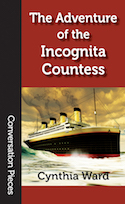
Definitely falling into the pulpish “with a mighty bound” school of SFFH, Cynthia Ward’s The Adventure of the Incognita Countess (Aqueduct Press) mashes up elements of Tarzan, Dracula, H.G. Wells’ Martians, and the Sherlock Holmes mythos in a spy caper set aboard the HMS Titanic. Amid thesteampunkish thrill of weaponized gloves and a stolen set of blueprints for Jules Verne’s proto-submarine Nautilus, Ward’s heroine experiences the throes of vampiric lesbian love and finds herself questioning her terribly problematic views on souls. Though short, this book throngs with action and its characters’ piercing emotional reactions to its tight plot.
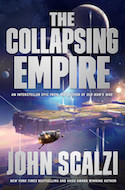
John Scalzi’s latest space opera The Collapsing Empire (Tor) shares the breezy, conversational tone of his popular blog, Whatever. Popes, cutthroat merchants, and dying emperoxes (in Scalzi’s non-gender specific nomenclature) complain about the weight of their coronation robes, the idiocy of officials, and the obstinacy of assassins. The novel’s premise is that after centuries of human use a faster-than-light path between star systems is fading out of existence. Within a decade.Switching viewpoints between a reluctant heir to the pan-stellar throne, a nerdish provincial mathematician, and a lusty smuggler of refugees, the author’s entertaining account of this so-called Interdependency’s unraveling inevitably ends in a cliffhanger. There will be a sequel. Maybe more than one — as noted on Whatever, Tor andScalzi just signed a 10-year contract. However manybooks he writes in this series, if they’re as easy on the eyes as this one, they’ll be welcome.
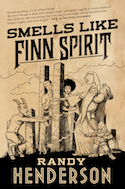
Smells Like Finn Spirit, (Tor) local author Randy Henderson’s third and final fantasy in the Familia Arcana trilogy, is as 80s-referential as the first two. Maybe more so. Though his rock star girlfriend is doing her best to catch him up on cultural developments that took place during his twenty-plus-year exile in fairyland, hero Finn Gramarye’s humorous take on the continuing war between fairies, wizards, and magical beings such as sasquatches and weresquirrels depends heavily on knowledge of that decade. Fortunately he gets cooperation in his preferences from those surrounding him: a sorcerer battles him in an illusory maze in the guise of Donkey Kong. His girlfriend disarms murderous fairies by singing pop songs with pointed lyrics.And so forth. If you’re unfamiliar with that time period, you’re best off reading volumes one and two of the series (Finn Fancy Necromancy and Bigfootloose and Finn Fancy Free) before starting this third one. Become grounded. That’s the best way to enjoy the buzz of being swept off your feet by Henderson’s guileless giddiness.
The Future Alternative Past: it's all about the L.O.V.E.
Every month, Nisi Shawl presents us with news and updates from her perch overlooking the world of science-fiction, fantasy, and horror. Read past columns here
Love Makes Our Worlds Go Round
The first story published in the SFFH series I mentioned last month, the Slate Magazine series on life under Presiden Trump, is a love story: Hector Tobar’s “The Daylight Underground.” Love moves the immoveable, and SFFH is rife with its primal and paradoxical power. Sometimes love is the motivation for the accomplishment of impossible journeys, as in John Crowley’s post-apocalyptic novel Engine Summer: hero Rush that Speaks traverses time and the troposphere in search of his lost love, Once a Day. Sometimes love’s workings are changed by a story’s science fictional or magical or horrific elements, as in Octavia E. Butler’s Fledgling, her last novel, in which a predator builds a polyamorous romantic relationship with its prey. Or as in C.J. Cherryh’s Foreigner series, in which a human linguist’s sexual involvement with his nonhuman bodyguard gradually adapts to very different emotional defaults rooted in their distinct biologies. Sometimes love is the means by which science fictional or magical or horrific change is brought about: in Ursula K. Le Guin’s groundbreaking novel The Left Hand of Darkness, ambisexual politician Estraven’s desire for male ambassador Genly Ai contributes to Estraven’s gender transformation.
There are plenty of other intersections between SFFH and love — even if we restrict our definition of love to the sort that’s sexual and romantic. Love and the fantastic imagination are twined together in a very twisty knot.
Often we fantasize privately about love — we dream impossibly erotic dreams, tell ourselves “meet-cute” stories that have no chance of ever coming true, and watch porn movies in our heads that we know we’ll never film. SFFH’s public fantasies have to have a greater degree of verisimilitude.
One of my favorite SFFH books-to-read-with-one-hand is Margaret and I by Kate Wilhelm. An Amazon reviewer called it “a profoundly unsettling and hallucinatory exploration of a woman’s sexual and emotional self-realization.” My note on the first page of my vintage 1978 paperback says it’s “good, and hot too!” Wilhelm’s undated inscription (probably circa 1999, when we met) informs me that I was “too young the first time around.” Surely not — when Margaret and I originally came out I was almost 16.
As for the less carnal sorts of love, when I want to swoon over the ideal knight, I read Tanith Lee’s Cyrion, or another novel-in-short-stories she wrote, Kill the Dead, or her somewhat-problematic romanticization of chattelhood, The Silver Metal Lover. When I want to get all starry-eyed over a lady, I turn to the strong and endearingly pessimistic heroines of Joanna Russ’s The Female Man and The Two of Them.
Then there are authors providing what you might call reliable surprises: Samuel R. Delany, who can write lyrical passages about the joy of snot-eating and the richly erotic pleasures to be found in cutting up raw potatoes. And Kai Ashante Wilson, who blows my professional author defenses to smithereens with rude yet gently balmy whisperings about entanglements between princes and soldiers and dead musicians.
Then there’s Lara Elena Donnelly’s debut novel Amberlough.
Recent books recently read

Love and sex drip from the pages of Amberlough (Tor) like mead from the rim of an upended bottle: sweet, yeasty, and bound to bring on fever-filled dreams. Set in an imagined secondary world similar to our own, this tale of espionage aimed against a Nazi-style populist movement is all too relevant to the current moment. Statuesque drag queen Aristide so truly loves twinkish spymaster Cyril DePaul that he fixes him up with a pseudo-girlfriend in the form of the frankly polyamorous Cordelia Lehane, Aristide’s costar at the decadent Bumble Bee Café. As in Ellen Kushner’s Riverside series, there’s no magic per se to be found within the pages of this fantasy of bedside manners, only the stinging fascination of seeing heart-stealing characters play out their desperate gambits against an ever-so-slightly defamiliarized background. From the slang for cigarettes (“straights” rather than “fags”) to streetcar-riding butch lesbians dodging brawling fascist demonstrations, Donnelly provides plenty of second-worldly details. It’s the sensual ones that stick, though: a breath, and then a knee parting thighs and then another, softer breath. The sights and sounds of a temporary heaven on earth.
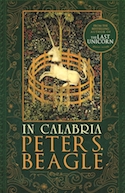
In Calabria (Tachyon Publications), Peter S. Beagle’s story of an Italian farmer encountering a gravid unicorn, is reminiscent of his 1968 masterpiece The Last Unicorn. But the new book emphasizes the interior transformations caused by this mythical animal. A simultaneous affair between 50-ish widower Claudio Bianchi and a fierce motorcyclist young enough to be his daughter reads alternately as metaphor for the irrationality and vulnerability of love and as simple wish fulfillment. The unicorn colt’s sire, black and furious, appears near the book’s end as counterbalance to the dam’s white beauty, a compelling vision of the positive masculine principle lacking in Beagle’s early work.
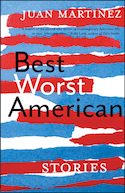
Readers of McSweeney’s Internet Tendency and the mainstream literary scene’s many small, high-prestige magazines may be familiar with Colombian American author Juan Martinez. Best Worst American (Small Beer Press), however, is his SFFH debut. Faithful to the transparency of contemporary genre-adjacent practices — simple statements of the unlikely, repeated refusals to linger on any comfortable thought or image — Martinez can still manage to impinge directly on the genre of SFFH itself via his subjects: immortal strippers, the end of the world, suburban housing developments empty of everything except myriad ghostly stillbirths. Brevity is another hallmark of modernity, but though this slim volume is filled with sleek, bold flash, its longer stories are also intensely affecting. “Hobbledehoydom” examines gracelessness in love in the light of Victorian novelist Anthony Trollope’s sad self-diagnosis. “Errands” follows an unfilial nine-year-old on a shopping trip through the forest where her parents live. Weirdness builds upon delectable weirdness throughout the whole book.
Cons and the conlike
The International Conference on the Fantastic in the Arts blends academic conference and SFFH convention together, and the result is a warm, salty success. Every March scholars and professional writers gather at the Orlando Airport Marriott Lakeside to explore fiction that flows along courses more outré than literature’s mainstream. A robust programming track includes dissertations on clones, robots, vampires, and the philosophical questions raised and answered by their imagined existence. There arealso readings by writers and panels on which they expound on their work — my favorite pronouncement being Ted Chiang’s description of himself as “entirely stitial.” Plus the pool’s lovely, the bar’s relaxed, and the alligator keeps her distance.
Ted’s remark, in case you missed his reference, was made in response to the label “interstitial.” Fiction which is interstitial occupies the notional territory between genres, and FOGcon 7’s theme is “Interstitial Spaces.” This new Bay Area convention welcomes authors Delia Sherman and Ayize Jama-Everett as its “Honored Guests,” and would like to welcome you as well. Highlights include the annual “Unaward Banquet” and Clarion-style writing workshops.
The Future Alternative Past: this dystopian hope
Unreality show
Interviewers sometimes ask me which mode of science fiction is easier to write: Utopia or dystopia? Look around you, I answer. Dystopian fiction is basically mimetic (realistic) fiction. It’s way, way too sodding easy to depict a scenario so ubiquitous; I choose to get my jollies envisioning the Utopian coolness that could be.
Equality and perfection are two hallmarks of Utopias. Especially for members of non-dominant groups like myself — women, queers, racial minorities, etc. — the status quo has long been anything but egalitarian, and its operating methods far from perfection. Even able, cis, white, heterosexual, young, middle class males are having hard times lately, though. Or so I hear from friends who fit those default categories.
We haven’t always inhabited this particular nightmare, and for decades science fiction/fantasy/horror has produced cautionary tales which could have warned us away from it. Thus my unease at the rise of “reality shows,” those television programs, common since the beginning of the millennium, in which supposedly unscripted action features non-actor celebrities and unknowns. I first encountered mention of them in extrapolated futures I wanted no part of, like James Tiptree, Jr.’s short story “The Girl Who Was Plugged In,” and “Baby You Were Great” and “Ladies and Gentlemen, This Is Your Crisis,” both by Kate Wilhelm. Novels from William Gibson, Barry Malzberg, and John Brunner fleshed out the picture: corporate ownership of governments; 24/7 surveillance; a culture of jaded, passive cynics.
Now a reality show star has been elected President of the United States. Now I’m living in the sort of world I didn’t even like reading about. Now I want to know how to change life’s channel.
So of course, being me, I turn to the imaginary.
Of published work, the most optimistic science fiction/fantasy/horror written recently on the topic of elections is Malka Older’s Infomocracy, a June 2016 publication that leaps a couple of decades ahead to a time when “microdemocracies” — non-geographical communities of 100,000 citizens — cover the globe. While Older’s depiction of how such a system would work — and fail — if put in place is entertaining in a governance geek way, this novel gives no turn-by-turn guidance on getting where it shows us winding up.
More promising in terms of finding a way forward, perhaps, are a pair of projects only lately underway. Ben Winters, Philip K. Dick and Edgar award-winning author of Underground Airlines, is putting together a series of stories “contemplating the future of our nation and world during and after a Trump presidency.” Scheduled to start appearing in Slate Magazine on Inauguration Day, these stories will be set in the 2016 presidential election’s immediate aftermath. Judging by the list of authors participating, bitterness, irony, and parody will probably be mixed with inventive strategies of resistance.
One prominent name on the list is crime fiction writer Gary Phillips, who will also edit The Obama Inheritance, an anthology in which contributors “riff on any one of dozens of teabagger-alt right conspiracy theories.” Time-traveling John Birchish saboteurs intent on destroying the president’s birth certificate, Michele wielding Pam Grier-worthy kung fu skills, and scenarios even more psychedelic than these seed the book’s proposal. In audacity there is hope.
Couple of upcoming cons
Held February 3-5, Foolscap is a small, local convention that wants you to decide what it will consist of. Members plan the weekend’s programming at a Friday afternoon meeting, scheduling panels and discussions around set pieces such as an auction, a banquet, and writing workshops. Their first Guest of Honor was Octavia E. Butler, and 2017’s is Patricia Briggs, but this con’s website claims that “Everyone is interesting.” Come take advantage of this least hierarchical of fandom’s famously non-hierarchical communities. And bring your brain; quoting again from Foolscap’s website, “Ideas make the best toys.”
Radcon is a more conventional convention, so to speak. It features the usual panels, gaming rooms, film viewings, and masquerades. Idiosyncratic strengths include well-organized school visitation sessions for professional writers; a chill, rambly hallway scene with an upright piano providing mood music; and a rave-like dance party.
Recent books recently read
If SFFH’s Golden Age is 12, as some insist, the genre’s Golden Format is the short story. Just the right size for having adventures in, short stories allow authors and readers to experiment with settings, ideas, characters, styles, so forth, so on, without making us invest huge wads of wordage. And anthologies with unifying themes both inspire these experiments and bring them together, thus making it easy to compare the ways they work.
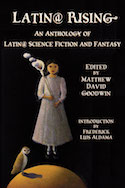
The editor of Latin@ Rising (Wings Press), Matthew David Goodwin,focuses on SFFH by US-connected Latinos/Latinas/Latinx writers. The closest comparable anthology is 2012’s Three Messages and a Warning, a book of new SFFH by modern Mexican authors. Though over a third of Goodwin’s selections are reprints, they’re of recent enough vintage that this book feels fresh and damp, as if the ink hadn’t yet made up its mind to dry. In particular I enjoyed the Klein bottlesque plot curvature of Kathleen Alcalá’s “The Road to Nyer” and Ernest Hogan’s far-too-relevant politipunk story “Flying under the Texas Radar with Paco and Los Freetails.”

Paying less attention to source than content, Jaym Gates and Monica Valentinelli, co-editors of Upside Down (Apex), asked contributors to invert “tropes,” worn storytelling clichés such as “The black man dies first” (full disclosure: I have a story in this book based on that very cliché). Their directive results in surrealistic premises such as the trendy small-appliance bodymodding in Adam-Troy Castro’s “The Refrigerator in the Girlfriend.” But it’s also interesting to see how some authors subvert their chosen tropes rather than simply standing them on their heads, as when in “Those Who Leave,” Michael Choi’s Asian scientist is emotionally driven rather than a stereotypical personification of cold, passionless intellect. Plenty of pleasure of all kinds here, including deeply moving weirdness from Michael Matheson and Haralambi Markov. A section of essays by academics and writing professionals on tropes in general and certain toxically tempting ones in particular adds further depth to this already thought-provoking anthology.
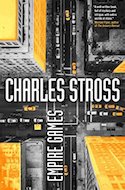
At the opposite end of the length spectrum from short stories lies the realm of the series — quartets, septologies, and the like. Charles Stross’s Merchant Prince series began, according to the late David Hartwell, as this notoriously “hard” SF-loving author’s attempt at writing fantasy. Sharing the multiverse premise and settings as well as several “worldwalking” characters with the Merchant Prince books, Empire Games (Tor) could be considered their seventh volume or, as it’s billed, the first of a related yet different series, the Paratime trilogy. Either way you read it, Stross’s latest will deliver vivid, unexpected, complicated fun.
The Future Alternative Past: Besties
Every month, Nisi Shawl presents us with news and updates from her perch overlooking the world of science-fiction, fantasy, and horror. You can also look through the archives of the column.
This time of year, everybody does it. I’ll be doing it soon myself: Making up lists. Second-guessing my picks. Justifying them. Libraries, book stores, bloggers, radio shows — pretty much anyone with an ax to grind and a public platform to grind it on will be sharing lists of the best books published in 2016. Or read in 2016. Or reviewed in 2016. Bests of one sort or another. Because there’s this urge to sum up any positive gains we’ve made by living through another year.
I contribute to annual “Best of” lists for Locus magazine and The Seattle Times. For the Times I pick one book — there can be only one — out of all those I’ve reviewed, and say in a single sentence what it’s about and why it’s the best. For Locus’s “Recommended Reading” I and several others spend weeks voting on a curated list of story titles. As I write this there are over 300 entries on the list. We hope to finish with around 120.
Aqueduct Press’s blog Ambling Along the Aqueduct hosts a series of posts covering the best books the publisher’s authors have read and/or the best music we’ve listened to and/or the best shows and films we’ve watched in a given year. After constructing and contributing to more restricted catalogs of bests, it’s peculiarly freeing to be able to write about not just the latest but the reconsidered greatest. In a past post to the series I geeked out on rereading the Harriet Vane/Peter Wimsey mysteries of Dorothy Sayers. Not only is Sayers no longer writing these, she’s dead. So is Octavia E. Butler, yet Kiini Ibura Salaam praised Toshi Reagon’s musical production of Butler’s Parable of the Sower in her “Best of 2015” round-up for Aqueduct. Because she could.
Similar in function to these lists are the numerous flourishing SFFH Year’s Best anthologies. Editor Gardner Dozois claims that if you don’t want to read his series’ most recent volume (he’s been compiling them since 1984) “you can squash a bug with it.” It’s true that these are pretty thick tomes. They include insightful analyses of the field and page after page of Honorable Mentions. Rich Horton, Jonathan Strahan, and the deceased David Hartwell have put out rival anthos, and for twenty years Ellen Datlow co-edited a companion Best of series for horror and fantasy. And there are others. SFFH is rich in short stories, especially with all the online magazines and crowdfunded collections available. These multiple “Best ofs” barely dent the surface of the genre’s tar pit, which is filled with inky gold.
Refining further on the concept of bests we come to awards. In SFFH there are many, and many are the ways their winners get chosen. Some selections are juried, like the Philip K. Dick Award for original US SFFH in paperback. Others are decided by polls, like the coveted Nebula Awards. But polls of whom? You have to be a member of SFWA (the Science Fiction Writers of America) to nominate or vote for Nebula candidates, and becoming a SFWA member takes more than money. Becoming a member of WorldCon, however, is a strictly financial matter, and WorldCon members select recipients of the equally prestigious Hugo Awards. As variously moody and/or diseased voting blocs have shown, you need not even attend. Slates for both the Rabid Puppies and the Sad Puppies have made their marks on the Hugo Awards for a couple of years running. Though their clearest mark so far has been a sweep of most Hugo categories by an author named “No Award,” that could change. I’ll let you know come next September.
Here come some cons
Meanwhile, there are other conventions to attend to. Maybe even to attend?
Arisia happens January 13 - 16, 2017, at the Westin Boston Waterfront. That’s in BOSTON! In JANUARY! Ride the “T” (like Seattle’s light rail, but older and better) from Logan airport to the hotel and then refuse to leave the Westin’s beautiful, wide-windowed lobby filled with Weeping Angels and anime characters for the rest of the cold, snowy weekend. Arisia is a good regional con, drawing on the Eastern Seaboard’s large and diverse fandoms to present panels featuring the likes of Smith College’s self-proclaimed Drama Queen Andrea Hairston, along with the usual weapons demos, masquerades, and so on. Such a good time to be had! I’ve gone to many an Arisia — handed out awards there, actually. I hope to go back some day.
However, next year I’ll be skipping Arisia in favor of the Black Comix Arts Festival taking place the same weekend in San Francisco. BCAF is part of that city’s Martin Luther King, Jr. celebration. 2016’s festivities were graced by Nigerian-American SFFH author Nnedi Okorafor, and 2017’s guests will include authors Tananarive Due and Ayize Jama-Everett, artist John Jennings, and, well, me. Join us!
Recent books recently read
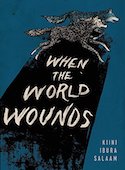
When the World Wounds (Third Man Books) is Kiini Ibura Salaam’s second short fiction collection. Her first,Ancient, Ancient, won the 2012 Tiptree Award with its fantastical and exuberantly sensual depictions of nonstandard gender roles. In language as richly raunchy as ever, she writes here of sentient wolves on the prowl, swamp witches caught up into the sky by extremely local storm fronts, and a ghost using the detritus of a tragic flood to make magic masks. Want to read fiction that’s original and strange? Here you go.
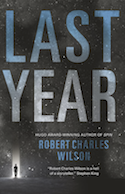
In Last Year (Tor) by Robert Charles Wilson, time’s colonizers face the same dilemmas as those confronting European imperialists. Following the logic of the many-worlds interpretation of time travel, 21st-century intrusions into mid-Victorian Era US history create new universes, where new events transpire. A modern entrepreneur opens a resort in 1876 Illinois and sells his contemporaries luxury tour packages. But how can he bear to make money off voyeurs watching horrible things happen to real people — the rise of the Ku Klux Klan, the genocide practiced against Indians? And what of the new atrocities their presence may trigger? Through the unassuming viewpoint of reformed drifter Jesse Cullum, Wilson shows the complex power differentials operating between staff, 19th-century natives, 21st-century tourists, and renegades intent on averting coming cataclysms. Add racial and sexual politics and you’ve got a book that’s both fun and challenging.
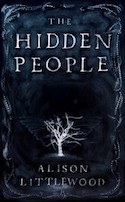
Alison Littlewood’s depiction of Victorian times in The Hidden People (Jo Fletcher Books) is a bit different: It takes place in a past divided from our present by more than years. The author’s fascination with “fairy burnings,” in particular the 1895 death of Irishwoman Bridget Cleary, led to this meticulously imagined novel of a bourgeois London gentleman investigating a northern cousin’s immolation under similar circumstances. In Yorkshire, Albert Mirrals gradually finds that the rational explanations he once entertained for what he believes was his cousin’s murder — domestic violence, jealousies — become entwined with the lyrical madness of possession. Quotations from Yeats and other poets magnify the effects of Littlewood’s carefully period prose.
The Future Alternative Past: our inaugural science fiction, fantasy, and horror column
New column! New Every month, Nisi Shawl is going to present us with news and updates from her perch overlooking the world of science-fiction, fantasy, and horror. Welcome Nisi!
Hello from your new skiffy columnist! I’m very gratified that I’ve been asked to provide you with monthly doses of clear-eyed science-fiction-fantasy-and-horror analysis, accompanied by the lamentation, kvelling, and Inside Baseball-like scuttlebutt you’d expect from a longtime reader and writer of that sort of thing. I promise to guide both trufen and neos (if you don’t know who those terms describe, you’re the latter) through the fantastic genres’ winding byways in the most pleasurable and interesting manner possible. In addition to my more general genre outpourings I’ve been charged with noting any upcoming conventions you may be interested in, and bringing you brief looks at recently published books.
Let’s begin with the conventions. Why?
Well, one major difference between science fiction/fantasy/horror (abbreviated hereinafter as SFFH) and other literatures is the communitarian legacy of early science fiction conventions. Damon Knight and the Futurians — a science fiction fan club rather than a surf rock band — organized the first World Science Fiction Convention, or Worldcon, way back in 1939. Though frequently eschewed by people of color, who can feel unwelcome in some of SFFH fandom’s whiter iterations, conventions (aka “cons”) have formed the genre’s powerful exoskeleton for almost 80 years now. Admittedly there were a couple of decades when falling con attendance rates were taken as predictors of SFFH’s fast-approaching demise. And many of those who did attend during the late 70s, the 80s, and even the early 90s, were as grey as they were white, leading to the expectation that con-going fandom as an institution would die of old age.
Lately, though, newer cons such as San Diego Comic-Con have sprung into existence. Appealing to a broader and often younger demographic, they embrace art forms reviled by some trufen (SFFH fandom’s hardened nerdcore): comics, movies, and even cartoons!
Though there’s no doubt some overlap in their memberships, two good examples of what I’m talking about can be found a couple hundred miles south of Seattle, in Portland, Oregon. By the time you read this, Orycon 38 (November 18 - 20, 2016) will be underway or over. As the number indicates, this is the 38th consecutive Orycon convention. I’ve attended quite a few. The panels, workshops, author signings, dances, freebie tables, art show, and vendor areas I’ve grown used to at other cons are always in evidence, with local literary luminaries supplementing the presence of national and international Guests of Honor such as Peter S. Beagle, Octavia E. Butler, and Steven Barnes.
But though you're probably not going to make Orycon, you’ve still got a good shot at attending Newcon PDX 5 (December 30, 2016 - January 1, 2017). Again as evidenced by the number, this is Newcon PDX the fifth. I’ve never been to even one of these. Events promised on the website range from a Cosplay Contest to a Swimsuit Cosplay Contest (“cosplay” is costuming based on characters found in popular books and shows), from gaming to tabletop gaming, from karaoke to a “Lip Sync Battle Royale.” As the self-proclaimed convention for “every flavor of nerd,” Newcon PDX of course offers panels, too, as well as special areas for vendors and artists. Photos of past attendees show a crowd with a hearteningly diverse racial make-up.
This last point is a great one because the historic whiteness of con-going fandom has been damaging — to POC who read and wrote and acted in SFFH works but felt unwelcome in its social spaces, and also to fandom as a whole, since they’re thus denied firsthand experience of our secret superpowers — or, to put that less fancifully, our perspectives and backgrounds. In 2009’s RaceFail, our participation in social media made it impossible for our existence to be denied, and POC also developed our own virtual and IRL safe spaces: the Carl Brandon Society advocated for them and organized panels on how to increase inclusivity at cons in particular and within fantastic literature as a whole, while groups such as the State of Black Science Fiction carved out online spaces for nerd-of-color community-building. Then, in 2010, Kate Nepveu ran her first auction to raise funds for Con or Bust, a nonprofit she created to offer scholarships to self-identified POC who want to attend cons. At first under the umbrella of the Carl Brandon Society and now on its own, Con or Bust has raised and distributed tens of thousands of dollars. That’s sadly still very necessary, as my write-up of the 2015 James Tiptree, Jr. Symposium at Eugene’s University of Oregon shows. Perhaps this year’s symposium, held December 2nd and 3rd in honor of writing goddess Ursula K. Le Guin, will be a bit more variegated.
Recent books recently read:

